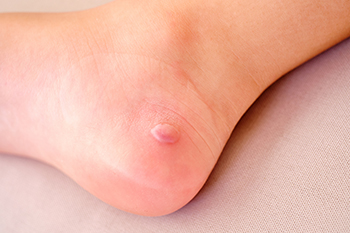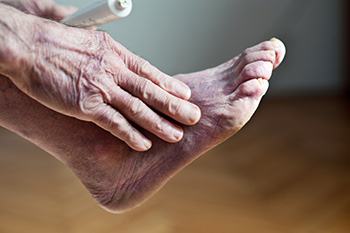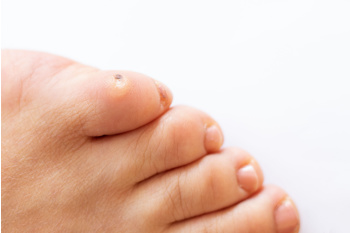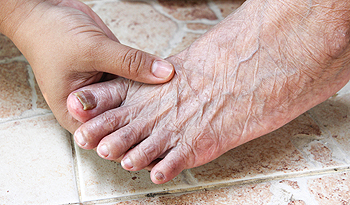Items filtered by date: June 2024
Blisters
Blisters are pockets of fluid that occur under the top layer of your skin. These fluid pockets are usually filled with pus, blood, or serum. Blisters may itch or hurt and can appear as a single bubble or in clusters.
The most common types of blisters are friction blisters. This type of blister may be caused by wearing shoes that are too tight. Friction blisters can also occur on the hands. A change in temperature may also cause blisters on the feet. In the freezing air, frostbite on your toes can lead to blisters, as well as sunburn from hot weather.
The best way to treat a blister is to keep it clean and dry. Most blisters will get better on their own. Once the skin absorbs the fluid within the blister, it will flatten and eventually peel off. You should avoid popping your blister unless you podiatrist does it for you. Additional treatment options include applying an ice pack to the blister or using over-the-counter blister bandages to cover the affected area.
If your blister becomes discolored, inflamed, or worsens it is advised that you speak to your podiatrist. Blisters that are yellow, green, or purple may be infected and require immediate medical attention. Blisters that are abnormally colored may be a sign of a more serious underlying health condition such as herpes.
Causes and Prevention of Friction Blisters
 Friction blisters of the feet are painful lesions caused by repetitive rubbing against the skin. These blisters typically occur on areas of the feet that experience frequent pressure or friction, such as the heels or toes. They appear as fluid-filled sacs beneath the top layer of skin and may cause discomfort when participating in daily activities, such as walking or even wearing shoes. Proper footwear, cushioning, and moisture control are essential for preventing friction blisters. If a friction blister develops, it's important to cover it with a bandage or blister pad, rather than popping it, to minimize the risk of infection. Establishing a hygiene routine for your feet is advised to decrease the likelihood of friction blisters. Additionally, wearing moisture-wicking socks can help maintain a dry environment in your shoes. If you notice signs of a friction blister developing on the foot, it is suggested to discuss personalized care and treatment options with a podiatrist to alleviate discomfort and prevent future blisters.
Friction blisters of the feet are painful lesions caused by repetitive rubbing against the skin. These blisters typically occur on areas of the feet that experience frequent pressure or friction, such as the heels or toes. They appear as fluid-filled sacs beneath the top layer of skin and may cause discomfort when participating in daily activities, such as walking or even wearing shoes. Proper footwear, cushioning, and moisture control are essential for preventing friction blisters. If a friction blister develops, it's important to cover it with a bandage or blister pad, rather than popping it, to minimize the risk of infection. Establishing a hygiene routine for your feet is advised to decrease the likelihood of friction blisters. Additionally, wearing moisture-wicking socks can help maintain a dry environment in your shoes. If you notice signs of a friction blister developing on the foot, it is suggested to discuss personalized care and treatment options with a podiatrist to alleviate discomfort and prevent future blisters.
Blisters are prone to making everyday activities extremely uncomfortable. If your feet are hurting, contact Jennifer Swan, DPM of Right Step Foot Care. Our doctor can provide the care you need to keep you pain-free and on your feet.
Foot Blisters
Foot blisters develop as a result of constantly wearing tight or ill-fitting footwear. This happens due to the constant rubbing from the shoe, which can often lead to pain.
What Are Foot Blisters?
A foot blister is a small fluid-filled pocket that forms on the upper-most layer of the skin. Blisters are filled with clear fluid and can lead to blood drainage or pus if the area becomes infected.
How Do Blisters Form?
Blisters on the feet are often the result of constant friction of skin and material, usually by shoe rubbing. Walking in sandals, boots, or shoes that don’t fit properly for long periods of time can result in a blister. Having consistent foot moisture and humidity can easily lead to blister formation.
Prevention & Treatment
It is important to properly care for the affected area in order to prevent infection and ease the pain. Do not lance the blister and use a Band-Aid to provide pain relief. Also, be sure to keep your feet dry and wear proper fitting shoes. If you see blood or pus in a blister, seek assistance from a podiatrist.
If you have any questions, please feel free to contact our office located in Westerville, OH . We offer the newest diagnostic and treatment technologies for all your foot care needs.
Causes, Symptoms, and Treatment of Poor Blood Circulation in the Feet
Poor blood circulation in the feet and legs is often caused by peripheral artery disease (PAD), which is usually the result of a buildup of plaque in the arteries. Plaque buildup, or atherosclerosis, can be the result of excess calcium and cholesterol in the bloodstream. This restricts how much blood can flow through arteries. Reduced blood flow to a certain area of the body severely limits the amount of oxygen and nutrients that part of the body receives. This leads to degeneration in the muscles and other tissues. Sometimes, poor blood circulation in the feet and legs can be caused by other conditions, such as the damaging or inflammation of blood vessels, known as vasculitis.
The lack of oxygen and nutrients caused by poor blood circulation can restrict muscle growth and development, as well as cause muscle pain and cramps, weakness, and stiffness. Other common symptoms include numbness in the legs and feet, skin discoloration in the affected limbs, slower nail and hair growth, and erectile dysfunction in men. In more severe cases of PAD, pain can be present even when a person isn't exercising, and may range from mildly uncomfortable to completely debilitating.
Poor blood circulation in the feet and legs is more common in those who are overweight or obese, have diabetes, high blood pressure, high cholesterol, who smoke, or who have a family history of PAD or related conditions such as a heart attack, stroke, etc. Diabetes and smoking place a person at greatest risk for developing poor blood circulation, although advanced age, over 50, can also increase risk.
If you are experiencing poor blood circulation in the feet and legs caused by PAD, it is important to make changes to your lifestyle in order to reduce your risk of experiencing a heart attack or stroke caused by this condition. If you smoke, quit completely. This will increase the amount of oxygen in your bloodstream. Exercising and reducing the saturated fats in your diet. Saturated fats come from fatty meats, fried foods, whole milk, etc., can make a difference in improving blood circulation in feet. It is also important to avoid developing influenza and to carefully control your blood sugar if you have diabetes.
Your doctor may recommend combining lifestyle changes with a prescription medication regimen to improve blood circulation. The most commonly-used medications for PAD are called statins and work by blocking the amount of enzymes in your body that produce cholesterol. They are known by the brand names Zocor, Lipitor, Crestor, and others.
Key Facts About Poor Foot Circulation

Poor foot circulation is a condition where blood flow to the feet is reduced, leading to various health issues. It often results in symptoms such as cold feet, numbness, and swelling. Common causes include diabetes, peripheral artery disease, and prolonged inactivity. Smoking and high cholesterol levels can also contribute to this condition. Poor circulation can delay healing of wounds and increase the risk of infections due to inadequate blood supply. Regular exercise, such as walking or stretching, can improve circulation by stimulating blood flow. Wearing compression socks can also help manage symptoms by promoting venous return. Maintaining a healthy diet and managing underlying conditions is essential for preventing poor foot circulation. Having poor foot circulation can be uncomfortable, and the causes often need to be identified before starting treatment. If you have poor foot circulation, it is suggested that you consult with a podiatrist who can properly diagnose this condition and offer appropriate relief solutions.
Poor circulation is a serious condition and needs immediate medical attention. If you have any concerns with poor circulation in your feet contact Jennifer Swan, DPM of Right Step Foot Care. Our doctor will treat your foot and ankle needs.
Poor Circulation in the Feet
Poor blood circulation in the feet and legs is can be caused by peripheral artery disease (PAD), which is the result of a buildup of plaque in the arteries.
Plaque buildup or atherosclerosis results from excess calcium and cholesterol in the bloodstream. This can restrict the amount of blood which can flow through the arteries. Poor blood circulation in the feet and legs are sometimes caused by inflammation in the blood vessels, known as vasculitis.
Causes
Lack of oxygen and oxygen from poor blood circulation restricts muscle growth and development. It can also cause:
- Muscle pain, stiffness, or weakness
- Numbness or cramping in the legs
- Skin discoloration
- Slower nail & hair growth
- Erectile dysfunction
Those who have diabetes or smoke are at greatest risk for poor circulation, as are those who are over 50. If you have poor circulation in the feet and legs it may be caused by PAD and is important to make changes to your lifestyle in order to reduce risk of getting a heart attack or stroke. Exercise and maintaining a healthy lifestyle will dramatically improve conditions.
As always, see a podiatrist as he or she will assist in finding a regimen that suits you. A podiatrist can also prescribe you any needed medication.
If you have any questions please feel free to contact our office located in Westerville, OH . We offer the newest diagnostic and treatment technologies for all your foot and ankle needs.
Corns and Calluses
A corn is a lesion that forms in the skin of the foot, and it is typically circular in shape, small in size, and thick and rough in texture. A corn generally occurs as a result of repeated pressure on the skin; one example of this is the rubbing of a shoe against the skin. Corns differ from calluses in that their central cores are harder in texture.
A corn is a relatively common condition with a wide variety of treatment options. If a corn becomes overly uncomfortable or painful, consult with your podiatrist; he can determine the best method of treatment that is appropriate for you. Corns may return if the underlying cause of its development is not treated or removed. Avoid removing corns at home, as improper removal may cause infection.
A callus, similar to a corn, is an area of skin that has become thickened due to repeated pressure and rubbing. The rubbing causes the skin to create a layer of protective skin, which is the formed callus. Calluses can differ in size between people, and they can also become painful.
Multiple treatments are available for calluses. At-home treatment and removal should be avoided, as this can potentially lead to infection. Your podiatrist can best determine the cause of your calluses and suggest the treatment most appropriate for you.
Difference Between Corns and Calluses
 Corns and calluses are common foot conditions that are often confused but have distinct differences. Corns are small, rounded areas of thickened skin that usually develop on bony areas like the top or sides of toes as a result of pressure or friction. Corns often develop from the consistent friction with ill-fitted shoes. Typically, corns have a hard core surrounded by inflamed skin that may cause discomfort or pain when pressure is applied. Calluses, on the other hand, are broader, more diffused areas of thickened skin that typically form on the soles of the feet or the palms of the hands. Calluses form as the body's way of protecting itself from ongoing rubbing or pressure from everyday activities like walking, working, or any kind of manual labor. Unlike corns, calluses generally do not cause pain but they may affect mobility if they grow too thick. Regular foot care and attention to shoe fit can help maintain healthy feet and prevent the development of these agitating conditions. If you suffer from persistent or painful corns and calluses, it is suggested that you visit a podiatrist for a proper evaluation and appropriate treatment recommendations.
Corns and calluses are common foot conditions that are often confused but have distinct differences. Corns are small, rounded areas of thickened skin that usually develop on bony areas like the top or sides of toes as a result of pressure or friction. Corns often develop from the consistent friction with ill-fitted shoes. Typically, corns have a hard core surrounded by inflamed skin that may cause discomfort or pain when pressure is applied. Calluses, on the other hand, are broader, more diffused areas of thickened skin that typically form on the soles of the feet or the palms of the hands. Calluses form as the body's way of protecting itself from ongoing rubbing or pressure from everyday activities like walking, working, or any kind of manual labor. Unlike corns, calluses generally do not cause pain but they may affect mobility if they grow too thick. Regular foot care and attention to shoe fit can help maintain healthy feet and prevent the development of these agitating conditions. If you suffer from persistent or painful corns and calluses, it is suggested that you visit a podiatrist for a proper evaluation and appropriate treatment recommendations.
If you have any concerns regarding your feet and ankles, contact Jennifer Swan, DPM of Right Step Foot Care. Our doctor will treat your foot and ankle needs.
Corns: What Are They? and How Do You Get Rid of Them?
Corns can be described as areas of the skin that have thickened to the point of becoming painful or irritating. They are often layers and layers of the skin that have become dry and rough, and are normally smaller than calluses.
Ways to Prevent Corns
There are many ways to get rid of painful corns such as wearing:
- Well-fitting socks
- Comfortable shoes that are not tight around your foot
- Shoes that offer support
Treating Corns
Treatment of corns involves removing the dead skin that has built up in the specific area of the foot. Consult with Our doctor to determine the best treatment option for your case of corns.
If you have any questions please feel free to contact our office located in Westerville, OH . We offer the newest diagnostic and treatment technologies for all your foot and ankle needs.
Treating Toenail Fungus
Fungal infection of the toenail, or onychomycosis, typically appears as a gradual change in a toenail’s texture and color that involves brittleness and darkening. The fungal infection itself occurs beneath the surface of the nail. Aside from discoloration, other symptoms include the collection of debris beneath the nail plate, white marks on the nail plate, and a foul odor emanating from the nail. If ignored, the infection can spread into other nails and the skin; in severe cases, it can hinder one’s ability to work or walk.
The toenails are particularly vulnerable to contracting infection in moist environments where people are likely to be walking barefoot, such as around swimming pools, public showers, and locker rooms. Fungal infection may also be more likely to occur in nail beds that have been injured, and sufferers of chronic diseases such as diabetes, circulatory problems, or immunodeficiency conditions are particularly prone to developing fungal nails.
Fungal nails can be primarily prevented by practicing proper hygiene and regularly examining the feet and toes. Carefully washing the feet with soap and water and thoroughly drying the feet afterwards are essential. Other tips include wearing shower shoes in public areas, changing shoes and socks daily, keeping toenails clipped at a short length, wearing breathable shoes that fit properly, wearing moisture-wicking socks, and disinfecting home pedicure tools and instruments used to cut nails.
Fungal nail treatment may vary between patients and the severity of the condition. Your podiatrist may suggest a daily routine of cleansing that spans over a period of time to ease mild infections. Over-the-counter or prescription antifungal agents may also be prescribed, including topical and/or oral medications. Debridement, or the removal of diseased nail matter and debris, may also be performed. In more severe cases, surgical treatment may be needed. In some instances, the temporary removal of the fungal nail allows for the direct application of a topical antifungal to the nail bed. In other cases, a chronically painful fungal nail that has not responded to other treatments may be permanently removed; this allows the infection to be cured and avoids the growth of a deformed nail.
Symptoms and Risks of Toenail Fungus

Fungal toenail infections, although not typically serious, can be quite persistent and challenging to treat. These infections often begin at the edge of the toenail, gradually spreading and causing the nail to become brittle, thickened, and discolored. You may notice your nails turning yellow or white, becoming crumbly, and even lifting off the nail bed, which can be accompanied by swelling and pain. Risk factors include consistently warm and damp feet, wearing tight or non-breathable shoes, and sharing personal items like nail clippers or towels. Untreated fungal toenails can lead to more serious health issues, and for severe or resistant fungal toenail infections, minor surgical procedures to remove the affected nail might be necessary. If you suspect a fungal toenail infection, especially if you have underlying health conditions, it is suggested that you schedule an appointment with a podiatrist to begin a tailored treatment plan.
If left untreated, toenail fungus may spread to other toenails, skin, or even fingernails. If you suspect you have toenail fungus it is important to seek treatment right away. For more information about treatment, contact Jennifer Swan, DPM of Right Step Foot Care. Our doctor can provide the care you need to keep you pain-free and on your feet.
Symptoms
- Warped or oddly shaped nails
- Yellowish nails
- Loose/separated nail
- Buildup of bits and pieces of nail fragments under the nail
- Brittle, broken, thickened nail
Treatment
If self-care strategies and over-the-counter medications does not help your fungus, your podiatrist may give you a prescription drug instead. Even if you find relief from your toenail fungus symptoms, you may experience a repeat infection in the future.
Prevention
In order to prevent getting toenail fungus in the future, you should always make sure to wash your feet with soap and water. After washing, it is important to dry your feet thoroughly especially in between the toes. When trimming your toenails, be sure to trim straight across instead of in a rounded shape. It is crucial not to cover up discolored nails with nail polish because that will prevent your nail from being able to “breathe”.
In some cases, surgical procedure may be needed to remove the toenail fungus. Consult with your podiatrist about the best treatment options for your case of toenail fungus.
If you have any questions, please feel free to contact our office located in Westerville, OH . We offer the newest diagnostic and treatment technologies for all your foot care needs.
